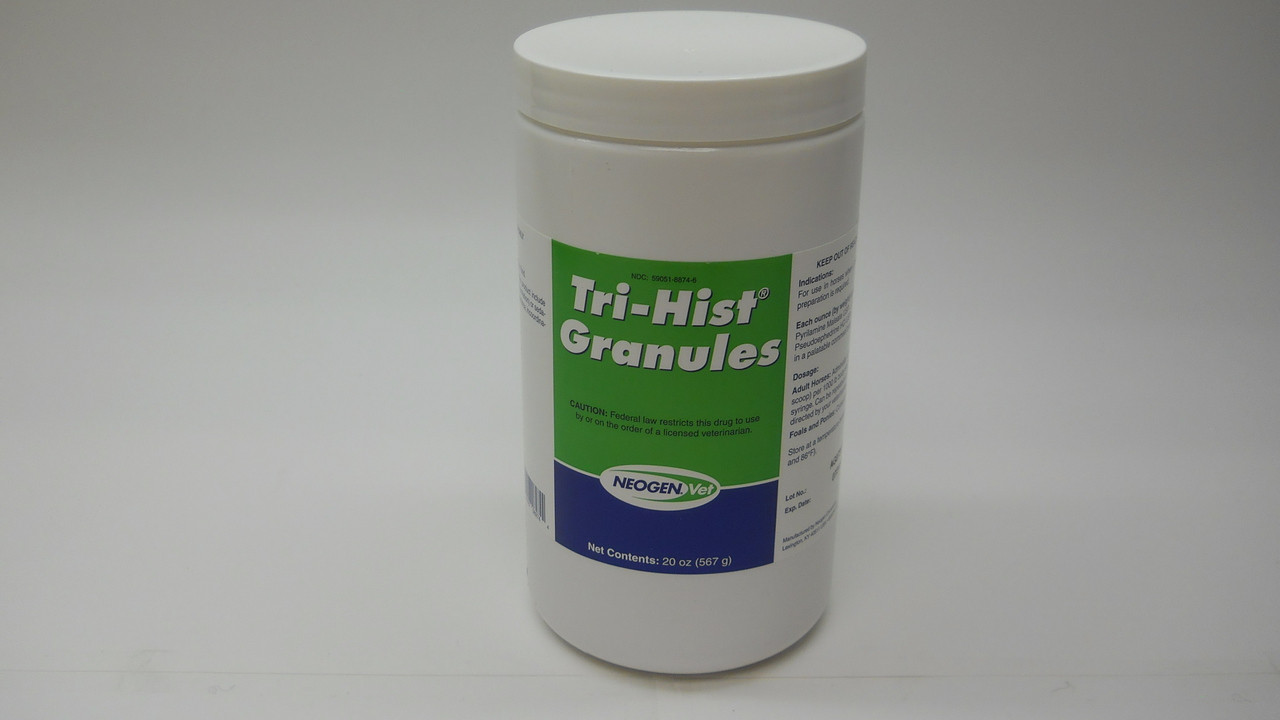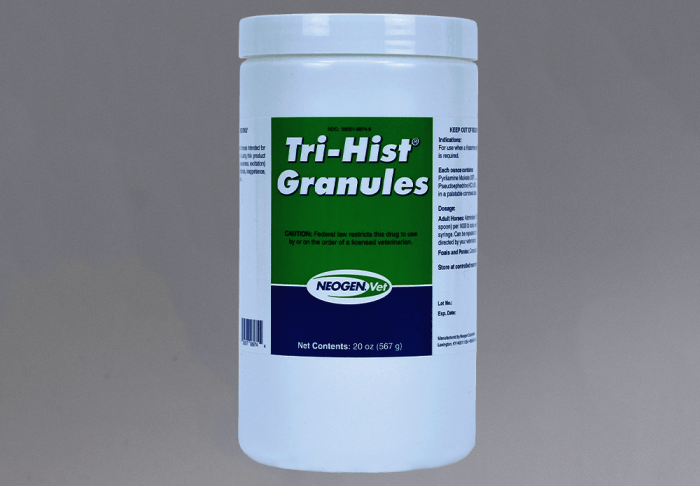Tri hist granules for horses are enigmatic structures that play a pivotal role in the horse’s intricate physiological processes. These granules, found within specialized cells, hold the key to understanding the delicate balance of hemostasis, inflammation, and overall equine well-being.
Delving into the nature and composition of tri hist granules reveals a fascinating world of cellular machinery. Their intricate components orchestrate a symphony of events, contributing to the horse’s ability to maintain a healthy circulatory system and respond to inflammatory challenges.
Tri Hist Granules

Tri hist granules are specialized secretory vesicles found in horses’ large intestine. They play a crucial role in the horse’s immune response and digestive health.
Composition of Tri Hist Granules
Tri hist granules are composed of three main components:
- Histamine:A chemical mediator that triggers inflammation and immune responses.
- Tryptase:A protease enzyme that degrades proteins and contributes to inflammation.
- Chymotrypsin:Another protease enzyme that assists in protein digestion.
These components work together to facilitate immune responses, promote inflammation, and aid in the digestion of proteins in the horse’s large intestine.
Role in Hemostasis

Tri hist granules play a pivotal role in hemostasis, the process that prevents excessive bleeding after blood vessel injury. They contain various proteins that contribute to the formation of a stable blood clot.
When a blood vessel is damaged, platelets adhere to the site of injury and release their contents, including tri hist granules. These granules contain:
- Platelet Factor 3 (PF3):PF3 activates thrombin, a key enzyme in the blood clotting cascade.
- Von Willebrand Factor (vWF):vWF binds to collagen at the site of injury, providing a scaffold for platelet adhesion.
- Fibrinogen:Fibrinogen is converted to fibrin by thrombin, forming a mesh-like network that traps platelets and red blood cells, creating a stable clot.
Thrombin Generation
Tri hist granules are crucial for thrombin generation. PF3 binds to the surface of platelets and interacts with Factor Xa, forming a complex that activates thrombin. Thrombin then converts fibrinogen to fibrin, initiating the formation of a stable blood clot.
Platelet Adhesion
vWF released from tri hist granules binds to collagen at the site of injury, providing a platform for platelet adhesion. This adhesion is further enhanced by the interaction between fibrinogen and the platelet surface receptor GPIIb/IIIa.
Histamine Release and Inflammation
Tri hist granules play a crucial role in the inflammatory response in horses. They contain histamine, a potent inflammatory mediator that triggers a cascade of events leading to vasodilation, increased vascular permeability, and recruitment of immune cells.Histamine release from tri hist granules is triggered by various factors, including:
Allergens
- Exposure to allergens, such as pollen or insect bites, can activate mast cells, leading to histamine release and the development of allergic reactions.
Physical trauma
- Physical injuries, such as cuts or abrasions, can damage mast cells and trigger histamine release, contributing to inflammation and pain.
Immune system activation
- Activation of the immune system, such as during an infection or immune response, can stimulate mast cells to release histamine, promoting inflammation and aiding in the defense against pathogens.
Clinical Significance
Tri hist granules play a crucial role in maintaining homeostasis and regulating inflammatory responses in horses. Abnormalities in these granules can lead to various clinical conditions.
Tri hist granules are a must-have supplement for horses, providing essential nutrients for optimal health. Speaking of learning resources, if you’re interested in exploring American Sign Language, I highly recommend checking out the true+way asl units 1-4 pdf . It’s a comprehensive guide that covers the basics of ASL, making it a great starting point for beginners.
Returning to the topic of horse care, tri hist granules remain a crucial element in ensuring your equine companion’s well-being.
Examples of Clinical Conditions
- Thrombocytopenia: Deficiencies in tri hist granules can impair platelet function, leading to reduced clot formation and increased bleeding risk.
- Immune dysregulation: Abnormalities in tri hist granules can affect histamine release and immune cell activation, contributing to inflammatory disorders such as allergies and autoimmune diseases.
- Coagulopathies: Dysfunctional tri hist granules can disrupt coagulation pathways, causing abnormal blood clotting and bleeding tendencies.
Impact on Horse Health
Altered tri hist granule function can have significant implications for horse health:
- Bleeding disorders: Impaired platelet function due to tri hist granule deficiencies can lead to excessive bleeding, posing risks during surgery, trauma, or even routine procedures.
- Immune dysfunction: Dysregulated histamine release and immune cell activation can contribute to chronic inflammation, allergic reactions, and autoimmune disorders, compromising overall health and well-being.
- Coagulation abnormalities: Disrupted coagulation pathways can lead to excessive bleeding or inappropriate clot formation, increasing the risk of life-threatening conditions such as pulmonary embolism or stroke.
Diagnostic and Therapeutic Implications

Evaluating tri hist granule function in horses plays a crucial role in diagnosing bleeding disorders and guiding therapeutic interventions. Understanding the diagnostic tests and potential therapeutic strategies can enhance the management of horse health.
Diagnostic Tests
- Platelet Aggregation Studies:Assess platelet aggregation response to various agonists, including ADP, collagen, and thrombin, to evaluate tri hist granule release.
- Platelet Flow Cytometry:Quantifies the surface expression of activation markers (e.g., CD62P) on platelets, indicating tri hist granule activation.
- Electron Microscopy:Visualizes tri hist granule morphology and content, providing insights into granule release and storage capacity.
Therapeutic Strategies
Targeting tri hist granules offers potential therapeutic avenues for improving horse health:
- Tri Hist Granule Transfusions:Replacing dysfunctional tri hist granules in horses with bleeding disorders can restore normal platelet function and reduce bleeding risk.
- Pharmacological Interventions:Medications like epinephrine and thromboxane A2 agonists stimulate tri hist granule release, enhancing platelet aggregation and hemostasis.
- Gene Therapy:Targeting genes involved in tri hist granule biogenesis and function holds promise for correcting inherited bleeding disorders in horses.
Research and Future Directions: Tri Hist Granules For Horses

The study of tri hist granules in horses is an evolving field, with recent advancements shedding light on their multifaceted roles. Ongoing research focuses on exploring the mechanisms underlying their formation, release, and biological functions.
Novel Techniques and Insights
Advanced microscopy techniques, such as super-resolution microscopy, have provided detailed visualizations of tri hist granule structure and dynamics. Researchers are utilizing genetic approaches to identify novel proteins involved in their regulation, opening avenues for understanding their biogenesis and secretion.
Targeting Tri Hist Granules for Therapeutic Interventions
Given their involvement in inflammatory responses and hemostasis, tri hist granules are potential therapeutic targets for equine diseases. Studies are exploring the development of drugs that modulate their release or function, with the aim of alleviating inflammatory conditions and promoting tissue repair.
Areas for Further Research, Tri hist granules for horses
- Unveiling the molecular mechanisms governing tri hist granule formation and release.
- Identifying the specific receptors and signaling pathways involved in their biological actions.
- Investigating the role of tri hist granules in equine respiratory and gastrointestinal disorders.
- Developing novel diagnostic tools to assess tri hist granule function in clinical settings.
Query Resolution
What are tri hist granules?
Tri hist granules are specialized structures found within certain cells in horses. They contain a unique combination of components that play a crucial role in various physiological processes.
How do tri hist granules contribute to hemostasis?
Tri hist granules release factors that promote blood clotting, helping to stop bleeding and maintain the integrity of the circulatory system.
What is the role of tri hist granules in inflammation?
Tri hist granules contain histamine, a chemical that triggers inflammation in response to injury or infection. This inflammatory response helps the body heal and protect itself.